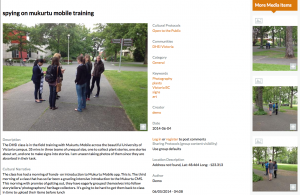Community
June 12, 2014
Re-envisioning Digital Heritage Management: “Mukurtu” and “Mukurtu Mobile”
This year at DHSI, I took the course titled “Cultural Codes and Protocols for Indigenous Digital Heritage Management”. This course utilized Mukurtu (pronounced mook-oo-too) CMS, an open source Drupal 7 platform for managing digital heritage, to explore the ways in which we can approach indigenous heritage materials (see http://www.mukurtu.org/).
Mukurtu allows for the marriage of traditional knowledge with data management, and its multi-authored commenting and free tagging capabilities promote an overall sense of polyvocality. Through its complex system of community-based permissions, the platform also communicates the webs of relations between places, ancestors, gender, and age, acknowledging the protocols imbued both within the community and those external to it. To determine the cultural protocols for a heritage item, one might consider the following: How do you want to share and manage access to this item? Who do you want to be able to view, add, or edit information? Is the content restricted to gender? Is the item sacred?
Our project for the week involved separating into three teams – Team Plants, Team Art, and Team Signs – and using the mobile app “Mukurtu Mobile” to incorporate fieldwork (photos taken around the UVic campus) into our demo sites. The app, while an excellent drain of my iPhone battery, allowed us to record information alongside each photo, and used geolocation to record our exact coordinates at the time each photo was taken. As a group, we needed to work together in order to determine the cultural protocols the applied to our content, in relation to possible viewing communities (our own team, DHSI, and UVic for example). We decided that some images should only be viewed by members of our group, Team Signs (strictest permissions), but that most images could be viewed by the DHSI/UVic communities (more public permissions).
Fig. 1 – Content generated by Mukurtu Mobile app and uploaded to Mukurtu site
When using this platform to manage heritage items in an indigenous community, the cultural protocols and sharing settings are extremely important. For example, certain heritage items may only be intended for males, specifically over the age of 18. Without these protocols in place within the Mukurtu system, anyone in the community would be able to view the items, creating an upset between traditional knowledge and the cultural codes put in place to govern it.
Our sample project was helpful, particularly for providing a hands-on experience navigating the Mukurtu interface; the project also sparked interesting discussions regarding permissions and protocols. Most importantly, this course forced me to consider the implications of my own research concerning West Coast First Nations literature. Through platforms like Mukurtu, it becomes possible to mediate the tension that has previously existed between technology and culture, and instead foster an environment focused on community-based heritage management.
